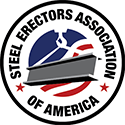Be sure to click the red subscribe button to receive your digital copy.
Projects in Arizona, Florida, Georgia, North Carolina and Texas July 10, 2024 (Winston-Salem, N.C.) The Steel Erectors Association of America (SEAA) announces the winners of its 2024 Projects of the Year. Two companies were recognized for Miscellaneous Metals and three for Structural Steel projects.
Projects that were topped out in 2022 or 2023 were eligible and must have been completed without significant accident or injury. Submissions are reviewed and winners are selected by an independent panel of judges from an engineering firm not affiliated with the association. “Only one of the five winning companies is a prior recipient of this award, and two of them are relatively new members of SEAA,” said Drew Heron, Chairman of the Awards Committee. “Regardless of the size or scope, each of these projects demonstrated the grit and talent it takes to be an ironworker,” he said. Winners receive trophies, feature article coverage in Connector magazine, and the chance to participate in peer panel discussions. Summaries provided below. June 27, 2024 (Winston-Salem, N.C), During the President's Dinner at the Steel Erectors Association of America’s 2024 Convention & Trade Show in Glendale, Arizona, two long-standing Board Members were recognized for their years of dedicated service. David Deem, Founder and President of Deem Structural Services, LLC, received the William Davis Service Award, and Chris Legnon, Vice President of Technology at Cooper Steel, was named SEAA’s Person of the Year. David Deem - 2024 William Davis Service Award (Left to right) Drew Heron, Chairman of SEAA’s Awards Committee, David Deem, President of Deem Structural Services, R. Pete Gum, SEAA's Executive Director
FOR IMMEDIATE RELEASE
Kenilworth, NJ -- Magni America LLC, a subsidiary of Magni Telescopic Handlers SRL, the global leader in rotating and heavy lift telehandlers, is excited to announce the grand opening of its new American headquarters. This event, held on June 18th, showcased a state-of-the-art facility designed to elevate customer support for the Magni brand. The grand opening was well attended and featured a keynote address by Riccardo Magni, President and Founder of Magni Telescopic Handlers, who shared insights on the company’s vision and its commitment to exceptional customer service. Guests enjoyed live music, and Italian cuisine and were given a tour of the new headquarters, highlighting its modern features and customer-focused design. Photo courtesy of Nucor Rebar Fabrication, Inc. via Advanced Construction Robotics website Advanced Construction Robotics (ACR), a leading innovator in construction robotics, announced it has entered into an agreement with Nucor Rebar Fabrication, Inc. (Nucor), North America’s premier fabricator and installer of rebar. This partnership marks a significant step forward in the construction industry, showcasing Nucor Rebar Fabrication’s dedication to safety by integrating modern technologies into its operations.
Image credit: Occupational Safety and Health Administration The clang of steel meeting steel, the hum of heavy machinery, the pop of a powder actuated tool, the scream from a saw, and the roar of construction activity. These are the sounds of the steel erection industry. However, there is a hidden danger: the threat of occupational noise exposure. Recognizing this risk, OSHA has established rigorous standards to ensure the hearing safety of workers. Additionally, modern technology that detects sound decibels, such as sound apps for a smartphone, has become a valuable tool in monitoring and managing noise exposure.
From GWY: Our industry relies on the innovation and passion of up-and-coming engineers and tradespeople. That’s why we’re proud to be a silver-level sponsor for this year’s Student Steel Bridge Competition, hosted by the American Institute of Steel Construction. For over 30 years, the Student Steel Bridge Competition has asked college students from across the U.S. to develop a solution to a real-life engineering challenge, then go head-to-head with their designs at the national finals. This year, the GWY team got to see the finalists present their scale-model steel bridge designs at Louisiana Tech University — and watched the University of Florida take home 1st Place! Competitions like these are invaluable for novice engineers to apply their classroom knowledge to real-world problems, and also to make industry connections with potential future employers and colleagues. Take a look at some highlights from the event:
CHICAGO - The American Institute of Steel Construction’s new Sustainability Partner Program is a win for specifiers, fabricators, and--of course!--the environment.
"Few people recognize that structural steel fabricators are the key player for a project's sustainability," said AISC Director of Sustainability and Government Relations Max Puchtel. "Fabrication itself accounts for less than 8% of structural steel's cradle-to-gate carbon footprint, but a fabricator's procurement responsibility means that their upstream influence is far greater." |











 RSS Feed
RSS Feed
